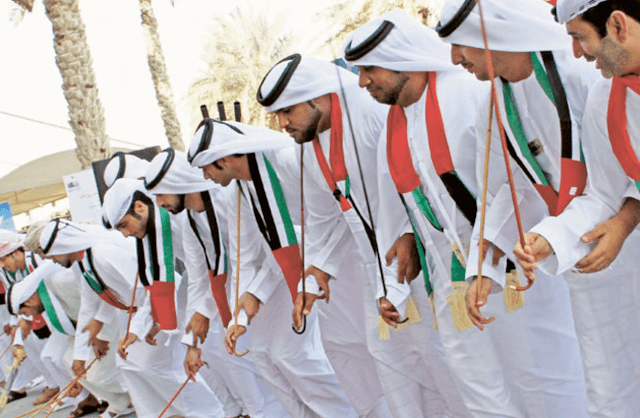 |
| Traditional Emirati Dance Forms to Explore |
Welcome to a world where culture and art come together in harmony. Traditional Emirati dance forms have been an integral part of the rich heritage of the United Arab Emirates for centuries. These dances are not just movements; they are a reflection of the Emirati spirit, history, and identity. In this article, we will take you on a captivating journey through the diverse and culturally significant Traditional Emirati dance forms to explore.
The Majestic Al Ayala Dance
Traditional Emirati dance forms to explore often begin with the grandeur of Al Ayala. This iconic dance is characterized by the rhythmic swaying of swords by skilled male dancers. The intricate footwork and precise choreography make it a sight to behold during special celebrations and national events.
Experience the elegance and precision of Al Ayala as it symbolizes the strength and unity of the Emirati people.
The Graceful Al Taghrooda Dance
Al Taghrooda is a dance that radiates grace and femininity. Performed by Emirati women, it showcases their elegance and beauty. Dancers move gracefully, adorned in traditional attire, and often accompanied by melodious poetry. Al Taghrooda captures the essence of Emirati culture and the strength of Emirati women.
Explore the beauty and tradition of Al Taghrooda, a dance that is a true reflection of Emirati grace.
The Energetic Al Harbiya Dance
Al Harbiya is a spirited dance that brings the Emirati warrior spirit to life. This energetic dance, originally performed by soldiers before battle, features synchronized movements with traditional weapons. Al Harbiya reflects the bravery and valor of the Emirati people and their strong sense of unity.
Discover the warrior within as you explore the rhythmic and powerful Al Harbiya dance.
The Enigmatic Liwa Dance
Liwa is a dance deeply rooted in Emirati history, particularly the traditions of the Bedouin tribes. Performed in the desert city of Liwa, this dance features intricate footwork and storytelling through graceful movements. Liwa dance pays homage to the desert landscape and the connection between the Emirati people and their natural surroundings.
Embark on a journey to the desert as you immerse yourself in the enigmatic Liwa dance.
The Captivating Al Razfah Dance
Al Razfah is a celebratory dance that is performed during joyous occasions, such as weddings and festivals. This lively dance is marked by rhythmic drumming and joyful expressions. Al Razfah embodies the Emirati spirit of joy and unity, bringing people together in celebration.
Feel the rhythm of joy and unity through the captivating Al Razfah dance.
Traditional Emirati Dance Forms: Frequently Asked Questions (FAQs)
What is the significance of Traditional Emirati dance forms?
Traditional Emirati dance forms hold immense cultural significance as they reflect the history, traditions, and values of the Emirati people. They are a source of pride and a way to preserve their rich heritage.
How can I experience Traditional Emirati dance forms?
You can experience Traditional Emirati dance forms at cultural festivals, heritage events, and museums in the United Arab Emirates. These dances are an integral part of Emirati culture and are often showcased to visitors.
Are there any specific dress codes for Traditional Emirati dance performances?
Yes, both male and female dancers wear traditional Emirati attire, including kandura (for men) and colorful dresses (for women). These outfits are an essential part of the dance and contribute to its authenticity.
What is the role of music in Traditional Emirati dance?
Music plays a crucial role in setting the rhythm and mood for Traditional Emirati dance forms. Live music, often accompanied by traditional instruments like the oud and drums, adds depth and emotion to the performances.
Can tourists participate in Traditional Emirati dance forms?
While tourists may not participate in the dances themselves, they are encouraged to watch and enjoy the performances. It's a great way to immerse oneself in Emirati culture and gain a deeper understanding of the traditions.
Are there any initiatives to preserve and promote Traditional Emirati dance forms?
Yes, the government of the United Arab Emirates has been actively involved in preserving and promoting Traditional Emirati dance forms. Cultural centers, museums, and educational programs are dedicated to ensuring these dances continue to thrive.
Conclusion
Traditional Emirati dance forms to explore offer a unique and captivating window into the cultural tapestry of the United Arab Emirates. From the majestic Al Ayala to the lively Al Razfah, these dances celebrate the rich history, unity, and traditions of the Emirati people. Immerse yourself in the beauty and grace of these dances, and you'll gain a deeper appreciation for the heritage of this remarkable nation.